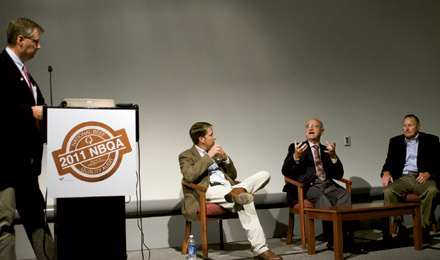2011 NBQA Documents Improvent, Establishes Critical Industry Benchmarks
Eating satisfaction, product integrity and telling the industry’s story seen as key to future.

DENVER, Colo. (July 26, 2012) — While the beef industry continues to make progress in the area of beef quality, there is still room for improvement. That’s the overarching conclusion of the 2011 checkoff-funded National Beef Quality Audit (NBQA) released during a session at the 2012 Cattle Industry Summer Conference in Denver.
The 2011 NBQA results show that the industry has made significant improvements in producing safe and wholesome beef that is consistently higher in quality, as proven by several measurable standards. Still, the three-phase checkoff-funded research, which took nearly a full year to complete and examined all facets of beef production, found there were several aspects — many associated with channel communication and consumer trust — on which the industry should strive to continue improving.
“The National Beef Quality Audit, conducted every five years, has always been the gold standard by which problems in the beef production chain have been identified for the past two decades,” says John Maas, veterinarian/specialist in cooperative extension at the University of California, Davis, and chairman of the checkoff’s Joint Producer Education Committee. “There have been a lot of important issues identified by past audits, and some major industry solutions, such as the development of Beef Quality Assurance (BQA) protocols, came about as a means of correcting those issues.”
Maas notes that the 2011 NBQA, a comprehensive examination of cow-calf, stocker, feedlot, packing and retail segments, showed significant progress in areas such as animal handling and attention to final product quality during the last 20 years. Since the first audit in 1991, in fact, adherence to BQA protocols has helped the industry reduce carcass blemishes, injection-site lesions and similar quality defects identified in early audits.
A shifting consumer landscape means that the beef industry faces a moving target with regard to meeting consumer demands and Maas says the 2011 NBQA includes important messages for each of the five industry segments surveyed. Specifically, he says every sector needs to be aware that their production practices can and do have a major impact on the finished beef product.
“Consumers need to be assured that the industry is doing everything it can, on its own, with its own funding to make sure we’re providing one of the best protein products in the world,” says Maas. That point was echoed by Craig Uden, vice chair of the Beef Promotion Operating Committee and producer from Elwood, Neb.
“The beef business has made tremendous progress in its efforts to provide consumers with a safe, wholesome and nutritious product that continues to exceed consumer expectations,” says Uden. “That hasn’t been an easy task because consumer expectations and market demand are undergoing constant change, and it can take cattlemen and women a long time to react to market signals after they receive them.”
Despite continuous improvement, the audit also found new areas that challenge quality and consumer perceptions of beef. Consumers are beginning to ask more questions about where their food comes from and how it is produced, and beef is no exception to that trend. The NBQA results clearly verify that fact.
“It’s clear we need to do a better job of telling our story — the story of beef production,” says Uden. “We need to be transparent about our methods, not just with consumers but also with each other. It’s important that we do a better job of sharing information between production segments and ensuring that market signals — the correct market signals — are being transmitted up and down the production chain. These results and the benchmarks we are measuring provide us the tools and framework we need to do just that.”
Barriers to progress identified in the NBQA Executive Summary were:
- Low level of written protocols
- Balancing needs of all industry segments
- Lack of trust between industry segments
- Disconnect with dairy
- Carcass inconsistency
- No common language
- Potential food safety issues
- Poor story-telling
The three phases of the research included extensive face-to-face interviews of representatives in all beef supply chain segments; expanded cooler and plant data that incorporates camera-grading from nearly 2.5 million carcasses in 17 federally inspected plants owned by four beef processing companies; and a pilot survey to evaluate quality indicators in pre-harvest segments of the industry. Results from the research were at the heart of discussions during an NBQA strategy workshop in April.
For a copy of the 2011 NBQA Executive Summary, visit www.bqa.org/audit.aspx, or contact Melissa Slagle at 402-856-2097 or Diane Henderson at 303-867-6302.
For more information about your beef checkoff investment, visit MyBeefCheckoff.com.
Editor’s Note: The articles used within this site represent a mixture of copyrights. This article was provided as a news release by the Beef Board. For the original release, visit MyBeefCheckoff.com.






